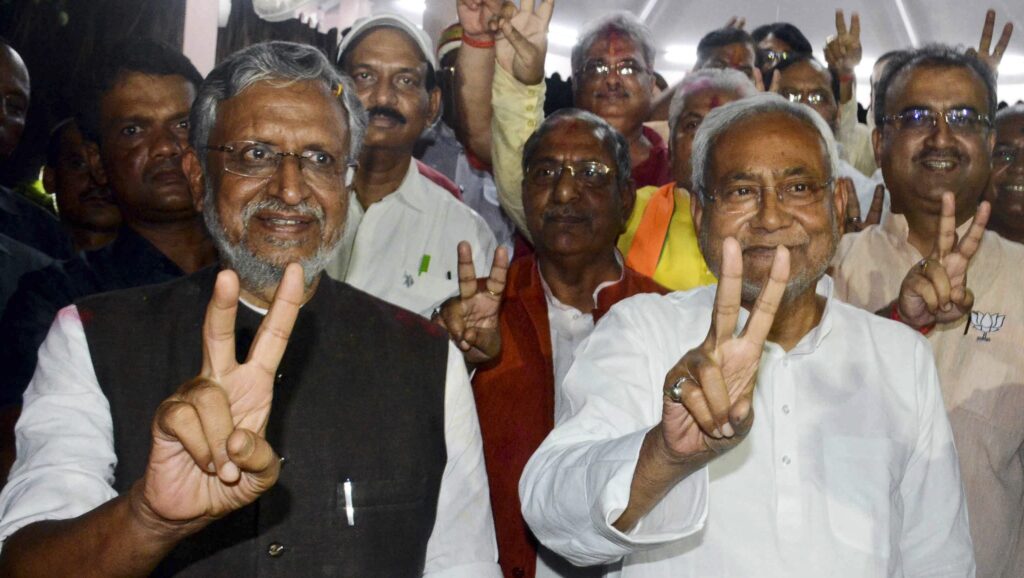“Wherever Hindu refugees settled after Partition, the Bharatiya Jana Sangh (BJS) began gaining influence while the Communists made an impact wherever there were factories and workers.” This popular saying from the 1950s and 1960s perfectly sums up the politics of Bihar.
If till 1990, this meant Congress dominance in the state, barring two brief interregnums between 1967-1972 and 1977-1980, it is also why the BJP, which is contesting an equal number of seats as its ally JD(U) for the first time in the state, has struggled to achieve a pan-Bihar appeal despite being the largest political party in the country.
Even as Narendra Modi serves his third consecutive term as Prime Minister, and neighbouring Uttar Pradesh has had a BJP government under Yogi Adityanath since 2017, Bihar still remains an unconquered frontier for the party.
Says political analyst Prem Kumar Mani: “The state saw the rise of the Communists, socialists and BJS/BJP almost simultaneously during the period dominated by the Congress. Yet, the BJP has failed to become a pan-Bihar party. Its dependence on Nitish for over 20 years speaks volumes. The Shahabad (Bhojpur, Rohtas, Kaimur and Buxar) and Magadh (Aurangabad, Gaya, Jehanabad, Arwal) regions have been known for socialist and leftist movements. The BJP’s results here (two of 21 seats in the 2020 Assembly polls and none in last year’s Lok Sabha elections) show it still has a mountain to climb. Nitish is still influential in the Kosi belt (Saharsa, Supaul and Madhepura) while (RJD chief) Lalu Prasad maintains his core (Muslim-Yadav) base. Given these circumstances, the BJP still needs partners to share power in the state.”
Seen as “politically untouchable” at one time, the BJS (the earlier avatar of the BJP) drew a blank in the 1952 and 1957 Assembly polls. It first tasted success in the 1962 Assembly polls, winning three seats — Siwan (Janardhan Tiwari), Munger (Jagadambi Prasad Yadav) and Nawada (Gourishanker Kesari) — in the 319-member House. Yadav, a powerful orator, made his mark with sharp critiques of Congress governments led by Vinodanand Jha and K B Sahay.
However, the BJS’s big moment came in 1967, when the Congress lost power in nine states, including Bihar, following Socialist leader Rammanohar Lohia’s anti-Congress campaign. The BJS found space in it as Lohia convinced his colleagues that a united Opposition was essential to challenge the Congress. Subsequently, Lohia and then RSS chief M S Golwalkar joined forces.
The Sanyukt Vidhayak Dal (SVD) government was then formed with Mahamaya Prasad Sinha as Chief Minister and Karpoori Thakur as his deputy. The BJS, which won 26 seats, saw three leaders get ministerial berths — Ramdev Mahato (Patna East), Vijay Kumar Mitra (Bhagalpur) and Rudra Pratap Sarangi (Saraikela, now in Jharkhand). The CPI too was part of the anti-Congress coalition.
During Bihar’s turbulent anti-Congress period between 1967 and 1972, which saw seven Chief Ministers, the BJS remained a marginal but persistent force. In the 1969 mid-term poll, the BJS won 34 seats and 25 in 1972.
Post the JP Movement, socialist stalwart Jayaprakash Narayan united the BJS, Charan Singh’s Bharatiya Lok Dal, socialist outfits and others to form the Janata Party, which won 214 of the 325 seats in the 1977 Assembly polls, paving the way for Karpoori Thakur to become CM. Erstwhile BJS veterans like Kailashpati Mishra and Thakur Prasad became ministers.
The BJS, which emerged as the BJP in the 1980 polls, was forced to lay low in three successive elections (1980: 21 seats, 1985: 16 seats, and 1990: 30 seats) as the Congress regained its dominance. It was later overshadowed by Lalu Prasad’s socialist surge between 1990 and 2000.
Only after allying with Nitish Kumar did the BJP sense it could challenge the RJD. In 2000, though the NDA lacked a majority, it was invited to form the government. Nitish took oath with just two ministers — Sushil Kumar Modi and Pashupati Kumar Paras. However, owing to the lack of numbers, the government collapsed within seven days, paving the way for Rabri Devi’s return as CM.
‘Dearth of leaders’
A section of the BJP believes that a “deficiency” of leaders continues to restrict the party in Bihar, unlike earlier when it could count Kailashpati Mishra, Thakur Prasad, Tarakant Jha, Govindacharya and Ashwini Kumar as among its founding members.
Mishra, the most prominent among them, spent much of his time in Katihar in the Seemanchal region, often sleeping at the railway station until party workers arranged a small room for him.
In an earlier interview with this correspondent, BJP leader and former Bihar Deputy CM, the late Sushil Kumar Modi, talked about Govindacharya cycling from village to village to counter the allegation that the RSS was linked to Mahatma Gandhi’s assassination. Recalling how “Sanghi” was once a term used with contempt, Modi credited Govindacharya and Mishra with working tirelessly to build a base for the BJP.
A senior BJP leader claims that Kailashpati Mishra never wanted Nitish projected as the NDA face. “Sushil Kumar Modi was the best we had. After him, we have been experimenting with former deputy CMs like Tarakishore Prasad and Renu Devi, and current Deputy CMs like Samrat Choudhary and Vijay Kumar Sinha. We are a party of mediocres,” the leader said.
Another leader pointed out that a year after the Modi wave elections of 2014, the BJP won only 53 seats in the 2015 Assembly elections in Bihar. “In 2020, we ceded the CM’s post to Nitish despite winning 74 seats as against the JD(U)’s 43. And now, (Union Home Minister) Amit Shah may have stopped shy of naming the NDA’s CM face, but Nitish will return as CM if his party wins 55–60 seats,” the leader added.

